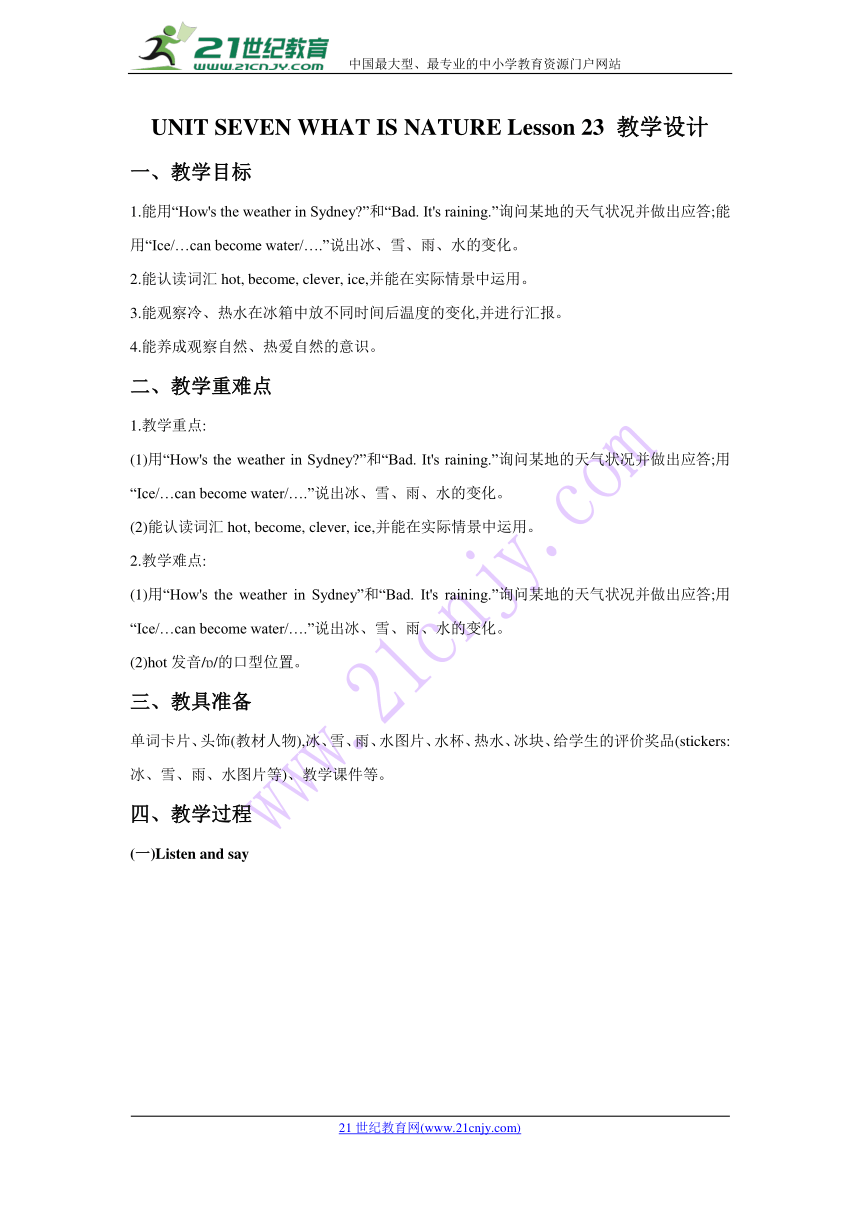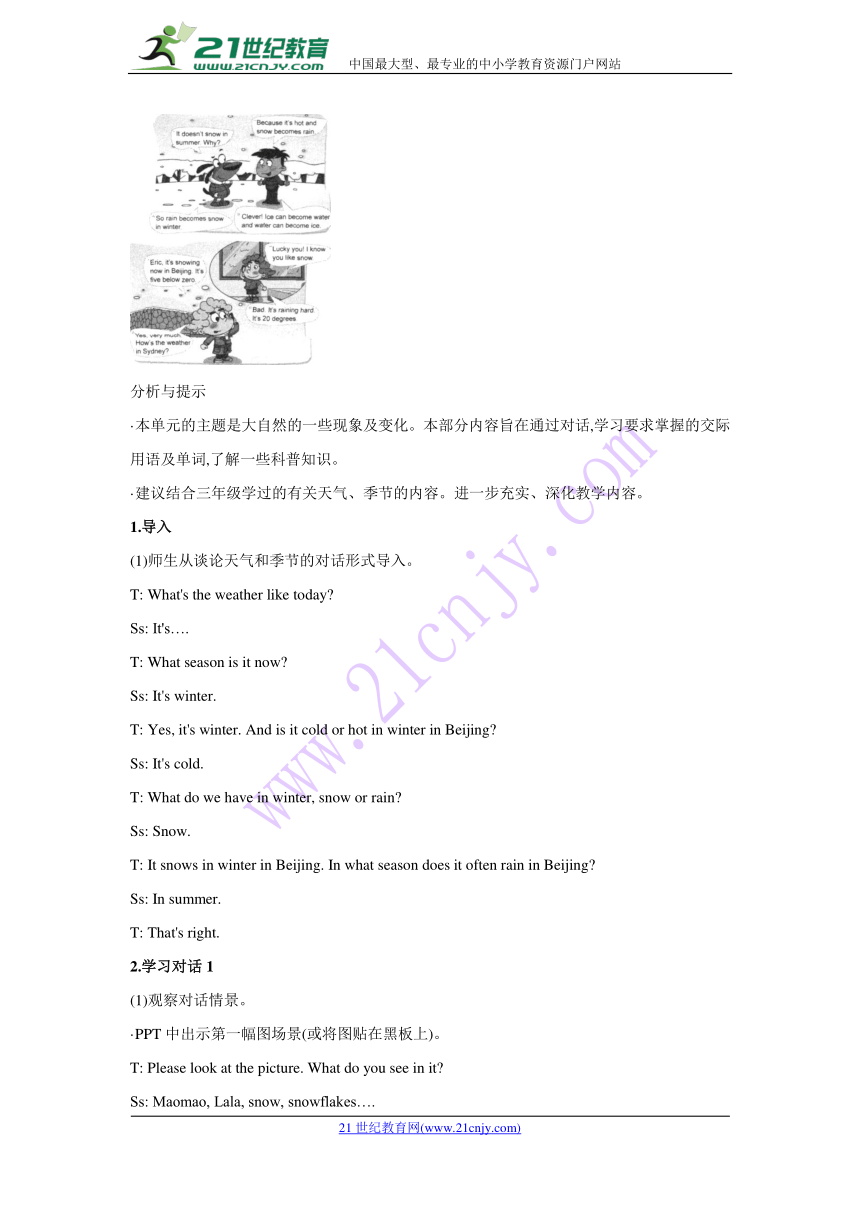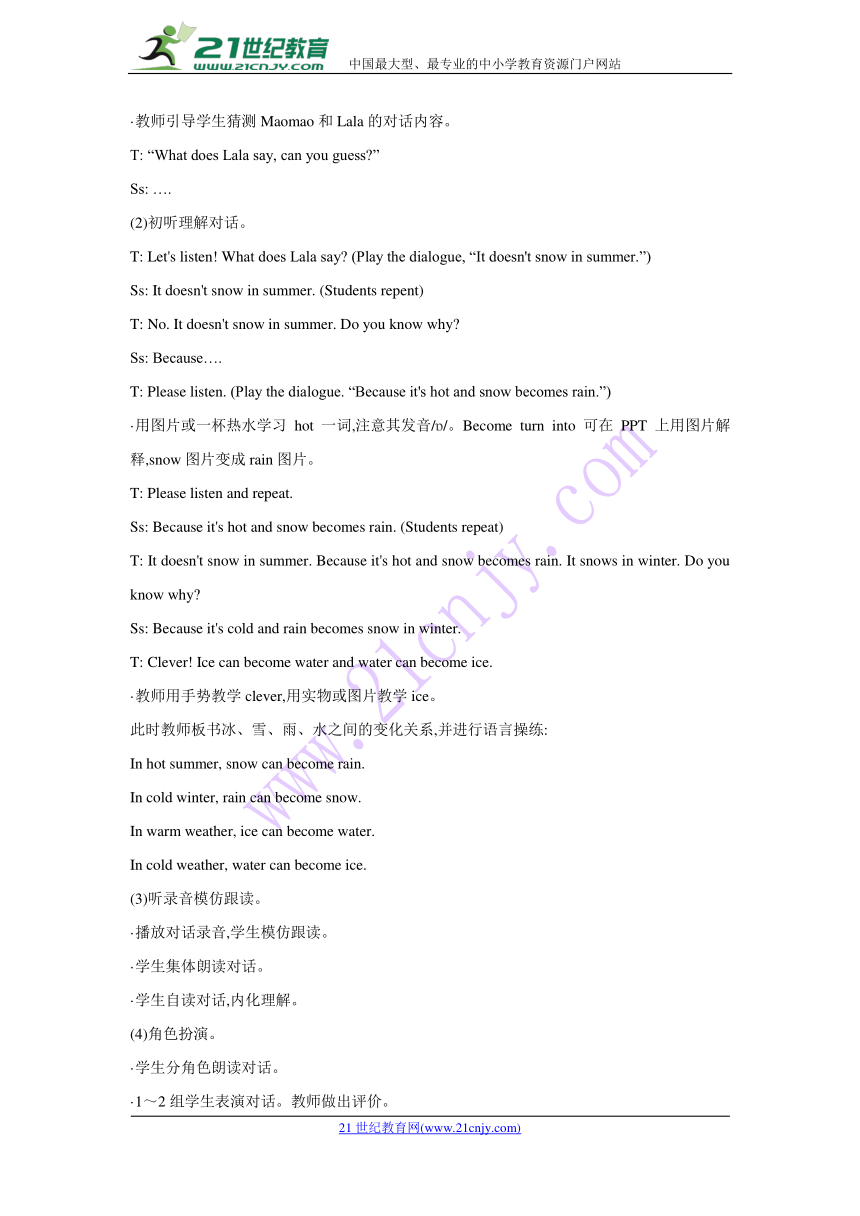Unit 7 What is nature Lesson 23 教学设计
文档属性
| 名称 | Unit 7 What is nature Lesson 23 教学设计 |  | |
| 格式 | zip | ||
| 文件大小 | 277.9KB | ||
| 资源类型 | 教案 | ||
| 版本资源 | 北京版 | ||
| 科目 | 英语 | ||
| 更新时间 | 2018-06-11 22:36:15 | ||
图片预览



文档简介
UNIT SEVEN WHAT IS NATURE Lesson 23 教学设计
一、教学目标
1.能用“How's the weather in Sydney?”和“Bad. It's raining.”询问某地的天气状况并做出应答;能用“Ice/…can become water/….”说出冰、雪、雨、水的变化。
2.能认读词汇hot, become, clever, ice,并能在实际情景中运用。
3.能观察冷、热水在冰箱中放不同时间后温度的变化,并进行汇报。
4.能养成观察自然、热爱自然的意识。
二、教学重难点
1.教学重点:
(1)用“How's the weather in Sydney?”和“Bad. It's raining.”询问某地的天气状况并做出应答;用“Ice/…can become water/….”说出冰、雪、雨、水的变化。21cnjy.com
(2)能认读词汇hot, become, clever, ice,并能在实际情景中运用。
2.教学难点:
(1)用“How's the weather in Sydney”和“Bad. It's raining.”询问某地的天气状况并做出应答;用“Ice/…can become water/….”说出冰、雪、雨、水的变化。2-1-c-n-j-y
(2)hot发音/?/的口型位置。
三、教具准备
单词卡片、头饰(教材人物),冰、雪、雨、水图片、水杯、热水、冰块、给学生的评价奖品(stickers:冰、雪、雨、水图片等)、教学课件等。21*cnjy*com
四、教学过程
(一)Listen and say
分析与提示
·本单元的主题是大自然的一些现象及变化。本部分内容旨在通过对话,学习要求掌握的交际用语及单词,了解一些科普知识。www-2-1-cnjy-com
·建议结合三年级学过的有关天气、季节的内容。进一步充实、深化教学内容。
1.导入
(1)师生从谈论天气和季节的对话形式导入。
T: What's the weather like today?
Ss: It's….
T: What season is it now?
Ss: It's winter.
T: Yes, it's winter. And is it cold or hot in winter in Beijing?【21cnj*y.co*m】
Ss: It's cold.
T: What do we have in winter, snow or rain?
Ss: Snow.
T: It snows in winter in Beijing. In what season does it often rain in Beijing?
Ss: In summer.
T: That's right.
2.学习对话1
(1)观察对话情景。
·PPT中出示第一幅图场景(或将图贴在黑板上)。
T: Please look at the picture. What do you see in it?【21教育名师】
Ss: Maomao, Lala, snow, snowflakes….
·教师引导学生猜测Maomao和Lala的对话内容。
T: “What does Lala say, can you guess?”
Ss: ….
(2)初听理解对话。
T: Let's listen! What does Lala say? (Play the dialogue, “It doesn't snow in summer.”)
Ss: It doesn't snow in summer. (Students repent)
T: No. It doesn't snow in summer. Do you know why?【21教育】
Ss: Because….
T: Please listen. (Play the dialogue. “Because it's hot and snow becomes rain.”)
·用图片或一杯热水学习hot一词,注意其发音/?/。Become turn into可在PPT上用图片解释,snow图片变成rain图片。21*教*育*名*师
T: Please listen and repeat.
Ss: Because it's hot and snow becomes rain. (Students repeat)21-cnjy*com
T: It doesn't snow in summer. Because it's hot and snow becomes rain. It snows in winter. Do you know why?
Ss: Because it's cold and rain becomes snow in winter.
T: Clever! Ice can become water and water can become ice.
·教师用手势教学clever,用实物或图片教学ice。
此时教师板书冰、雪、雨、水之间的变化关系,并进行语言操练:
In hot summer, snow can become rain.
In cold winter, rain can become snow.
In warm weather, ice can become water.
In cold weather, water can become ice.
(3)听录音模仿跟读。
·播放对话录音,学生模仿跟读。
·学生集体朗读对话。
·学生自读对话,内化理解。
(4)角色扮演。
·学生分角色朗读对话。
·1~2组学生表演对话。教师做出评价。
3.学习对话2
(1)观察图片情景,猜测人物话语。
·PPT中出示第二幅图场景(或将图贴在黑板上)。
T: Please look at the picture. What can you see in it?21世纪教育网
Ss: Eric, Mike, snow, rain, mobile phone,....
·教师引导学生猜测Eric和Mike的对话内容:“What are they talking about, can you guess?”
(2)初听理解对话。
·T: Let's listen. (播放一遍录音,验证学生答案)What are they talking about?
Ss: They're talking about the weather.
T: Yes. You are so right!
·播放对话录音,听录音前教师提问:“How's the weather in Sydney? How's the weather in Beijing?”教师讲解并板书“How's the weather in…?=What's the weather like in…?”
Ss: It's raining in Sydney. It's snowing in Beijing.21教育网
T: Check the answers.
(3)听录音模仿跟读。
·教师播放对话录音,学生模仿跟读。
·学生集体朗读对话。
·学生自读对话,内化理解。
(4)角色扮演。
·学生分角色朗读对话。
·1~2组学生表演对话。教师做出评价。
(二)Listen, look, and learn
分析与提示
·本部分提供了三个不同城市的天气情况。供学生进行替换句型练习。教师可以根据学生具体情况。结合Listen and say部分,进行综合练习。www.21-cn-jy.com
1.词汇学习
(1)教师用图片呈现下雨时的悉尼图片。
T: How's the weather in Sydney?
Ss: Bad. It's raining.
教师板书这两个重点句型,并依次呈现阳光明媚的昆明图片,下雪的阿拉斯加图片,让学生依次问答,进行替换练习。同时补充板书:“How's the weather in Sydney/Kunming/Alaska? Bad/Fine/Cold. It's raining/shining/snowing.”21·cn·jy·com
(2)根据板书,全班问答、男女生问答、小组问答练习。
(3)找1~2组学生根据板书问答展示。教师做出评价。
2.巩固练习
(1)教师提供更多城市及天气状况图片,在PPT上呈现,供学生巩同练习句型使用。
如:in Shanghai/Fine. It's shining.(给出阳光明媚的图片)
in Harbin/Cold. It's snowing. (给出下雪的图片)
in Tianjin/Bad. It's raining. (给出下雨的图片)
…
(2)结合Listen and say第二幅图对话内容,进行城市和天气状况的替换练习。如:
A: Ben, it's shining now in Shanghai. It's fifteen degrees.2·1·c·n·j·y
B: Lucky you! I know you like sunshine.
A: Yes, very much. How's the weather in Harbin?
B: Bad. It's cold. It's 20 below zero.
…
(3)学生可以小组内自编城市及天气状况对话,组内练习,全班展示。
(4)以上三个巩固练习,教师可根据学生情况选用。
(三)Let's do
分析与提示
·本部分内容为不同温度的水放在冰箱中温度的变化。学生在观察的同时,练习表达温度的句型。使学生养成注意观察、热爱自然的意识。21·世纪*教育网
(1)教师PPT出示冰箱及两杯分别为70℃和20℃的水的图片。
T: What can you see in this picture?
Ss: Two glasses of water.
T: Can you see the degrees of the two cups of water?
Ss: 70 degrees and 20 degrees.
(2)教师PPT出示冰箱及两杯分别为69℃和19℃的水。
T: Look! After 1 minute, it's 69 degrees and 19 degrees.
(3)教师继续出示5分钟后,10分钟后,15分钟后,20分钟后,25分钟后,30分钟后的变化,学生观察,小组练习,并汇报。教师做出评价。
五、可供选择的教学活动
1.游戏:Guessing game
目的:练习天气状况词汇,以及句型“How's the weather? It's raining/….”
(1)全班练习。
·教师依次拿出不同天气状况的图片,问学生,“How's the weather?”学生猜“Is it raining/snowing/shining…?”【21·世纪·教育·网】
(2)4人的小组练习。
·教师为每组学生准备不同天气状况的卡片。
·一名学生问,组内其他学生猜测。小组内可轮换,不同的学生问、猜。
2.游戏:说出合成词、反义词、同义词
目的:构词法的渗透。
(合成词)snow: snowman, snowball, Snow White
(合成词)ice: ice cream, icebox, ice sports
(反义词)hot: cold
(同义词)become=turn into
一、教学目标
1.能用“How's the weather in Sydney?”和“Bad. It's raining.”询问某地的天气状况并做出应答;能用“Ice/…can become water/….”说出冰、雪、雨、水的变化。
2.能认读词汇hot, become, clever, ice,并能在实际情景中运用。
3.能观察冷、热水在冰箱中放不同时间后温度的变化,并进行汇报。
4.能养成观察自然、热爱自然的意识。
二、教学重难点
1.教学重点:
(1)用“How's the weather in Sydney?”和“Bad. It's raining.”询问某地的天气状况并做出应答;用“Ice/…can become water/….”说出冰、雪、雨、水的变化。21cnjy.com
(2)能认读词汇hot, become, clever, ice,并能在实际情景中运用。
2.教学难点:
(1)用“How's the weather in Sydney”和“Bad. It's raining.”询问某地的天气状况并做出应答;用“Ice/…can become water/….”说出冰、雪、雨、水的变化。2-1-c-n-j-y
(2)hot发音/?/的口型位置。
三、教具准备
单词卡片、头饰(教材人物),冰、雪、雨、水图片、水杯、热水、冰块、给学生的评价奖品(stickers:冰、雪、雨、水图片等)、教学课件等。21*cnjy*com
四、教学过程
(一)Listen and say
分析与提示
·本单元的主题是大自然的一些现象及变化。本部分内容旨在通过对话,学习要求掌握的交际用语及单词,了解一些科普知识。www-2-1-cnjy-com
·建议结合三年级学过的有关天气、季节的内容。进一步充实、深化教学内容。
1.导入
(1)师生从谈论天气和季节的对话形式导入。
T: What's the weather like today?
Ss: It's….
T: What season is it now?
Ss: It's winter.
T: Yes, it's winter. And is it cold or hot in winter in Beijing?【21cnj*y.co*m】
Ss: It's cold.
T: What do we have in winter, snow or rain?
Ss: Snow.
T: It snows in winter in Beijing. In what season does it often rain in Beijing?
Ss: In summer.
T: That's right.
2.学习对话1
(1)观察对话情景。
·PPT中出示第一幅图场景(或将图贴在黑板上)。
T: Please look at the picture. What do you see in it?【21教育名师】
Ss: Maomao, Lala, snow, snowflakes….
·教师引导学生猜测Maomao和Lala的对话内容。
T: “What does Lala say, can you guess?”
Ss: ….
(2)初听理解对话。
T: Let's listen! What does Lala say? (Play the dialogue, “It doesn't snow in summer.”)
Ss: It doesn't snow in summer. (Students repent)
T: No. It doesn't snow in summer. Do you know why?【21教育】
Ss: Because….
T: Please listen. (Play the dialogue. “Because it's hot and snow becomes rain.”)
·用图片或一杯热水学习hot一词,注意其发音/?/。Become turn into可在PPT上用图片解释,snow图片变成rain图片。21*教*育*名*师
T: Please listen and repeat.
Ss: Because it's hot and snow becomes rain. (Students repeat)21-cnjy*com
T: It doesn't snow in summer. Because it's hot and snow becomes rain. It snows in winter. Do you know why?
Ss: Because it's cold and rain becomes snow in winter.
T: Clever! Ice can become water and water can become ice.
·教师用手势教学clever,用实物或图片教学ice。
此时教师板书冰、雪、雨、水之间的变化关系,并进行语言操练:
In hot summer, snow can become rain.
In cold winter, rain can become snow.
In warm weather, ice can become water.
In cold weather, water can become ice.
(3)听录音模仿跟读。
·播放对话录音,学生模仿跟读。
·学生集体朗读对话。
·学生自读对话,内化理解。
(4)角色扮演。
·学生分角色朗读对话。
·1~2组学生表演对话。教师做出评价。
3.学习对话2
(1)观察图片情景,猜测人物话语。
·PPT中出示第二幅图场景(或将图贴在黑板上)。
T: Please look at the picture. What can you see in it?21世纪教育网
Ss: Eric, Mike, snow, rain, mobile phone,....
·教师引导学生猜测Eric和Mike的对话内容:“What are they talking about, can you guess?”
(2)初听理解对话。
·T: Let's listen. (播放一遍录音,验证学生答案)What are they talking about?
Ss: They're talking about the weather.
T: Yes. You are so right!
·播放对话录音,听录音前教师提问:“How's the weather in Sydney? How's the weather in Beijing?”教师讲解并板书“How's the weather in…?=What's the weather like in…?”
Ss: It's raining in Sydney. It's snowing in Beijing.21教育网
T: Check the answers.
(3)听录音模仿跟读。
·教师播放对话录音,学生模仿跟读。
·学生集体朗读对话。
·学生自读对话,内化理解。
(4)角色扮演。
·学生分角色朗读对话。
·1~2组学生表演对话。教师做出评价。
(二)Listen, look, and learn
分析与提示
·本部分提供了三个不同城市的天气情况。供学生进行替换句型练习。教师可以根据学生具体情况。结合Listen and say部分,进行综合练习。www.21-cn-jy.com
1.词汇学习
(1)教师用图片呈现下雨时的悉尼图片。
T: How's the weather in Sydney?
Ss: Bad. It's raining.
教师板书这两个重点句型,并依次呈现阳光明媚的昆明图片,下雪的阿拉斯加图片,让学生依次问答,进行替换练习。同时补充板书:“How's the weather in Sydney/Kunming/Alaska? Bad/Fine/Cold. It's raining/shining/snowing.”21·cn·jy·com
(2)根据板书,全班问答、男女生问答、小组问答练习。
(3)找1~2组学生根据板书问答展示。教师做出评价。
2.巩固练习
(1)教师提供更多城市及天气状况图片,在PPT上呈现,供学生巩同练习句型使用。
如:in Shanghai/Fine. It's shining.(给出阳光明媚的图片)
in Harbin/Cold. It's snowing. (给出下雪的图片)
in Tianjin/Bad. It's raining. (给出下雨的图片)
…
(2)结合Listen and say第二幅图对话内容,进行城市和天气状况的替换练习。如:
A: Ben, it's shining now in Shanghai. It's fifteen degrees.2·1·c·n·j·y
B: Lucky you! I know you like sunshine.
A: Yes, very much. How's the weather in Harbin?
B: Bad. It's cold. It's 20 below zero.
…
(3)学生可以小组内自编城市及天气状况对话,组内练习,全班展示。
(4)以上三个巩固练习,教师可根据学生情况选用。
(三)Let's do
分析与提示
·本部分内容为不同温度的水放在冰箱中温度的变化。学生在观察的同时,练习表达温度的句型。使学生养成注意观察、热爱自然的意识。21·世纪*教育网
(1)教师PPT出示冰箱及两杯分别为70℃和20℃的水的图片。
T: What can you see in this picture?
Ss: Two glasses of water.
T: Can you see the degrees of the two cups of water?
Ss: 70 degrees and 20 degrees.
(2)教师PPT出示冰箱及两杯分别为69℃和19℃的水。
T: Look! After 1 minute, it's 69 degrees and 19 degrees.
(3)教师继续出示5分钟后,10分钟后,15分钟后,20分钟后,25分钟后,30分钟后的变化,学生观察,小组练习,并汇报。教师做出评价。
五、可供选择的教学活动
1.游戏:Guessing game
目的:练习天气状况词汇,以及句型“How's the weather? It's raining/….”
(1)全班练习。
·教师依次拿出不同天气状况的图片,问学生,“How's the weather?”学生猜“Is it raining/snowing/shining…?”【21·世纪·教育·网】
(2)4人的小组练习。
·教师为每组学生准备不同天气状况的卡片。
·一名学生问,组内其他学生猜测。小组内可轮换,不同的学生问、猜。
2.游戏:说出合成词、反义词、同义词
目的:构词法的渗透。
(合成词)snow: snowman, snowball, Snow White
(合成词)ice: ice cream, icebox, ice sports
(反义词)hot: cold
(同义词)become=turn into
同课章节目录
- Unit 1 Why are you so happy?
- Lesson 1
- Lesson 2
- Lesson 3
- Lesson 4
- Unit 2 May I speak to Mike?
- Lesson 5
- Lesson 6
- Lesson 7
- Lesson 8
- Unit 3 Will you do me a favour?
- Lesson 9
- Lesson 10
- Lesson 11
- Lesson 12
- Unit 4 Revision
- Lesson 13
- Lesson 14
- Unit 5 Which kind would you like?
- Lesson 15
- Lesson 16
- Lesson 17
- Lesson 18
- Unit 6 May I take your order?
- Lesson 19
- Lesson 20
- Lesson 21
- Lesson 22
- Unit 7 What is nature?
- Lesson 23
- Lesson 24
- Lesson 25
- Lesson 26
- Unit 8 Revision
- Lesson 27
- Lesson 28
